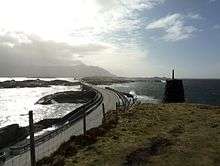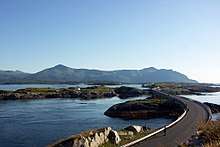Averøy
Averøya is an island on the mid-western coast of Norway, located in Møre og Romsdal county. The municipality Averøy is mainly formed by a relatively large main island, partly split up by a fjord, but there is also several small islands and islets in the north-west.
Many people describe Averøy as a "miniature of Norway" as all the landscape typical to Norway is represented here. The island is also famous for being one of the two municipalities connected by The Atlantic Road (Atlanterhavsveien)

Understand
Averøy has deep roots to the ocean. In the earlier times land was seen upon more as a barrier than a route of transportation. The boat has always been the preferred way of transport and this has clearly effected the settlements on the island and the surroundings. Until the 60s the island was divided into three municipalities. The island only got connected to the mainland as late as 1989.
Fishing and farming has always been the main industry here. Industry related to shipping and fish farming is also amongst the biggest industries on the island. The oil-related business in Kristiansund nearby has also become a large actor when it comes to labour.
Get in
By car
Situated on the coastline between Molde and Kristiansund, Averøy is reachable by the state road "Rv 64" running straight through it connecting the two earlier mentioned cities. In the west, towards Molde, the Rv 64 connects Averøy to the mainland as The Atlantic Road (Atlanterhavsveien). In the northeast the Rv 64 dives into the ocean, as The Atlantic Ocean Tunnel, connecting the island to Kristiansund.
By bus
The two bus companies Nettbuss Møre and Eide Auto is cooperating and have routes passing through Averøy from both Kristiansund and Molde every one or two hours in the weekdays. In the weekends you can expect about three departures a day.
Get around
Your own car or motorcycle is the best way to get around and travel at your own speed.
For bus options, look in the "Get in" section.
For additional information regarding public transportation in Møre og Romsdal, contact the public transport information "Trafikanten Møre og Romsdal" on the phone number 177.
Cycling is a good option for exploring Averøy as main roads on the island have no steep hills worthy of mentioning and the traffic is rather low. With all that said, the long distances make it hard to explore the entire island in, e.g., one day.
See

- 🌍 Atlanterhavsveien (The Atlantic Road), Kårvåg. Averøy's most popular attraction is a 8km long piece of road connecting Averøy to the mainland via a stretch of several islets connected by 8 bridges. The road was voted as construction of the century in 2005 and is one of Norway's top ten landscape based tourist attractions. For the most spectacular view you should visit on a sunny day in the spring or summer, or when there is a storm. In the summertime, this place is crowded by campers but still worth a visit. From one of its islets, Geitøya, there is possible to go by boat to Håholmen on request. Free.
- 🌍 Håholmen (Boat from Geitøya). An earlier fishing station situated on the islet/island "Håholmen", only reachable by boat from Atlanterhavsveien. Since its origin on the early 17th century it has been an important place for fishermen in hundreds of years. The island is now only partly inhabited caused by the hotel and restaurant business going on. Well worth a visit. Free.
- 🌍 Kvernes Stave Church. This church is one of the youngest of Norway’s 28 stave churches. Built around the 13th century.
- 🌍 Bremsneshola (The Bremsnes Cave), Bremsnes. This is a huge cave in the mountain Bremsneshatten measuring about 80 meters in length and 4 - 12 meters in width. In the area around the cave and the mountain it is found multiple remains after settlements from the Stone Age. free.
- Kvernes Folk Museum (Kvernes Bygdemuseum). The main yard of the museum with its 11 buildings form a typical coastal farming environment the way it was around the 18th to 19th century. Her you can find farmhouses, storehouses and "fire-houses" (Eldhus) from different eras.
- Søbstadklubben Rock Carvings (Søbstadklubben Petroglyphs). Whales carved into the mountainside, probably from the early Stone Age, approximately 5000 years ago. ago. Free.
- 🌍 Hestskjæret Lighthouse. Built in 1879, this is one of the lighthouses overlooking the hazardous Hustadvika. It used to be inhabitated, but has been automated since 1986. It is still an important landmark but is not very much visited due to its inaccessibility.
- 🌍 Håkårøysa (The Håkon Cairn). Nordmøre's biggest burial mound from the Viking age. It's unknown who or what lies there, but it is clear that a substantial amount of labour was put into this grave. free.
- 🌍 Sveggesundet, Sveggen. Small village situated on both sides of a beautiful strait next to the Norwegian Sea. Go here for an authentic experience of life by the sea. free.
- 🌍 Meek-knoken. The tallest mountain on the island, it is 751 m above sea level. On a nice day you can see the windmills on Smøla, over 50 km away. free.
- 🌍 Pilespisser ("Arrowheads"), Langøy. Art installation made by Kristian Blystad that honors Norway's "Magna Carta" when King Magnus in 1040 summoned a "ting" in Langøysund to come to an agreement with the coastal farmers of Norway. free.
- 🌍 Bremsnes Thing place (Bremsnes tingkrets), Bremsnes. Meeting place from the viking age in shape of a ring of stones. Bremsnes has likely been a chiefdom for more than 1500 years. Legends claims that Harald Hairfair (Harald Hårfagre) once betted with Rognvald, Earl of Møre (Ragnvald Mørejarl) that he would not cut his hair or beard until Norway was unified to one country. After the final battle at Hafrsfjord it is said he then travelled to Bremsnes to cut his hair around year 885 AD. This is supposed to have happened in this ring of stones. free.
- Kvernes Thing place (Kvernes tingkrets), Kvernes. Meeting place from the Viking age in shape of a ring of stones. free.
- Dyrset and Fagerfjellet Copper Mines. There was mining on several sites on the island in the period from 1806 to 1917. The sites still exist, but are not well kept. free.
Do
- Strømsholmen Sea Sport Center.
- Fishing from the fishing bridges on The Atlantic Road or rent a boat
- Hiking across the mountains in the centre of the island or along the seafront at one of the many islands
- Boat trips to one of the many islands. Orøya would be an excellent choice on a nice summer day.
- Marine safari to look for whales and seals
- Diving
Eat
- 🌍 Averøy Restaurant og Pizzeria, Bruhagen. Go here for your casual burger, pizza, etc.
- 🌍 Bjartmars favorittkro, Kårvåg (At the Averøy side of The Atlantic Road), ☎ +47 71516060, e-mail: post@favorittkro.no. Traditional Nordic cuisine made of local produce. Award-winning Bacalao.
Drink
- Averøy Restaurant
Sleep
- Åkviktunet.
- Atlanterhavsveien Sjøstuer.
- Feskberja.
- Kvernes Utleie.
- Hustadvika Gjestegård.
- Leithe Gård.
- Lysø Camping.
- Rangøy Rorbu.
- Skjerneset Bryggecamping.
- Sveggvika.
In Norway it is also allowed to camp everywhere temporarly (max two days) at a "fair" distance from cultivated areas. This makes camping in a tent a cheap and popular option. Much of Averøya is uncultivated, so there are many places where this is possible.
Contact
Averøy Turist Information
- Address: Sentrumsbygget, Bruhagen, 6530 Averøy
- Phone: (+47) 71 51 44 77
- Fax: (+47) 71 51 44 78
- Mobile: (+47) 92 22 51 58
- E-mail: post@bedriftnordvest.no
Go next
- Kristiansund
- Bud
- Molde